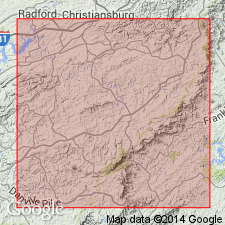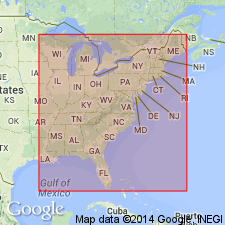
- Usage in publication:
-
- Willis Phyllite
- Modifications:
-
- Named
- Dominant lithology:
-
- Phyllite
- AAPG geologic province:
-
- Piedmont-Blue Ridge province
Summary:
Named for Willis Ridge, Floyd Co., southwestern VA. Underlies Willis Ridge and also composes two belts that trend east-northeast with their geographical centers on either side of VA Hwy 221 near Kings store. Consists of a highly crenulated garnet-bearing phyllite. Top of unit grades into Lynchburg formation through many hundred feet of alternating layers of phyllite like the Willis proper and layers of mica schist-gneiss indistinguishable from Lynchburg mica schist. (Lynchburg as used here may not be correlative of type locality Lynchburg). Base of Willis not recognized in Floyd Co.; phyllite unit may be wholly beneath the Lynchburg and may even represent facies of Little River gneiss (new), or it may be wholly within the Lynchburg and therefore be a member of that formation. May be same general age as some rocks in Blue Ridge complex. [Age is Precambrian.]
Source: GNU records (USGS DDS-6; Reston GNULEX).

- Usage in publication:
-
- Willis Phyllite
- Modifications:
-
- Not used
- AAPG geologic province:
-
- Piedmont-Blue Ridge province
Summary:
Alum Phyllite and Willis Phyllite of Dietrich (1959) are not used. Rocks previously assigned to those formations are here assigned to the Wills Ridge Formation (new). Report includes geologic maps, correlation chart, and isotopic data.
Source: GNU records (USGS DDS-6; Reston GNULEX).
For more information, please contact Nancy Stamm, Geologic Names Committee Secretary.
Asterisk (*) indicates published by U.S. Geological Survey authors.
"No current usage" (†) implies that a name has been abandoned or has fallen into disuse. Former usage and, if known, replacement name given in parentheses ( ).
Slash (/) indicates name conflicts with nomenclatural guidelines (CSN, 1933; ACSN, 1961, 1970; NACSN, 1983, 2005, 2021). May be explained within brackets ([ ]).

